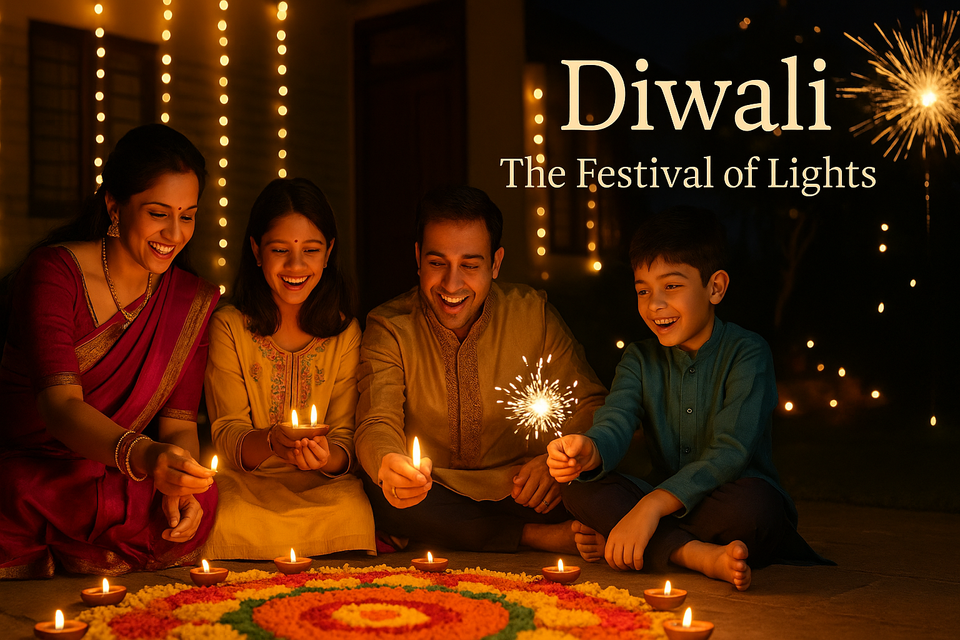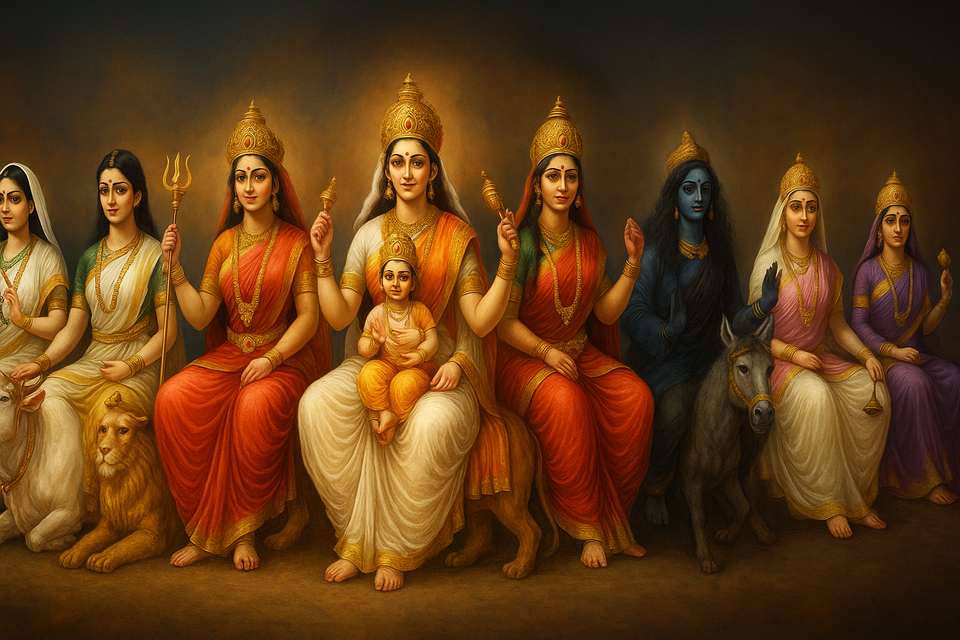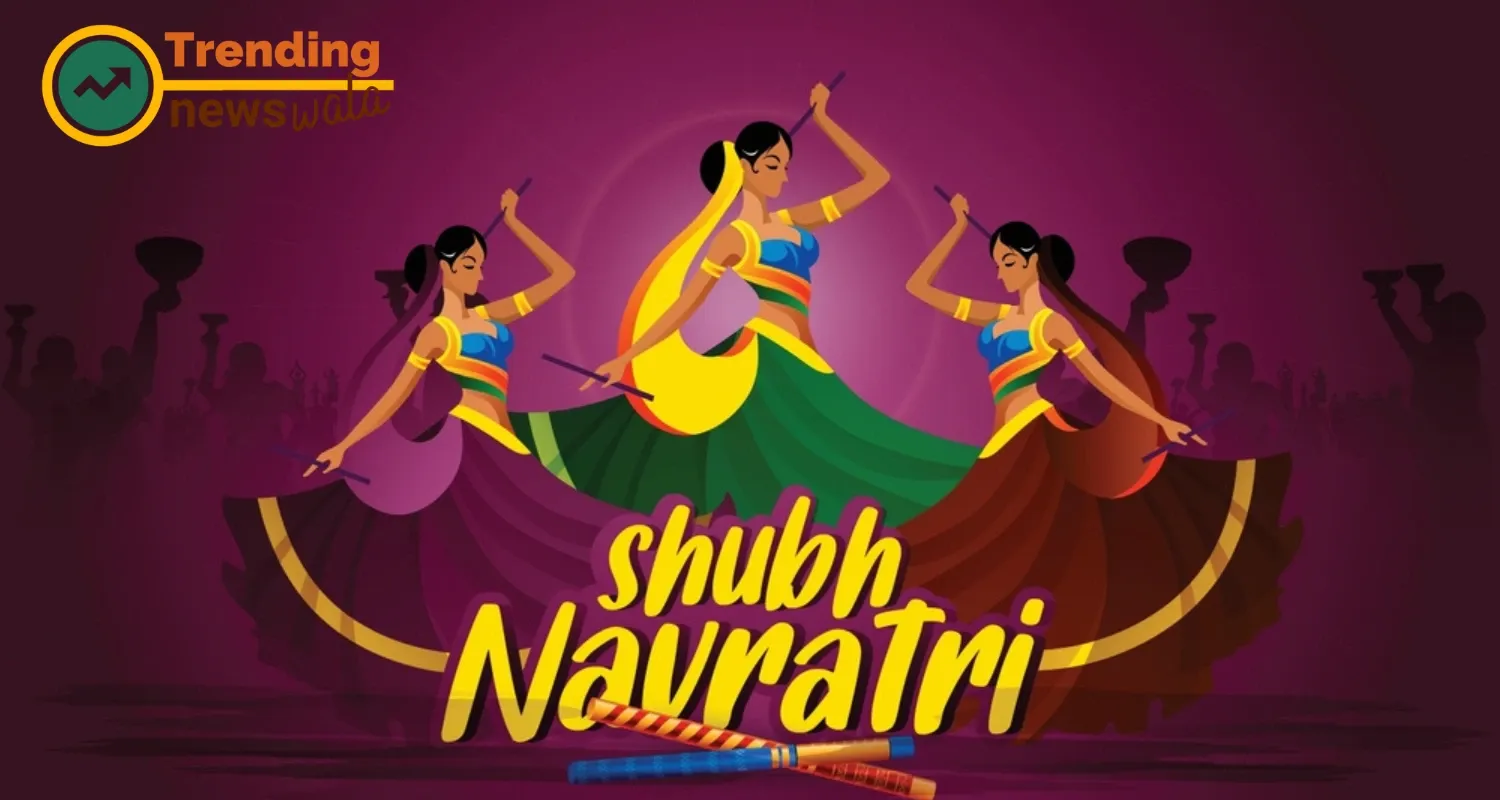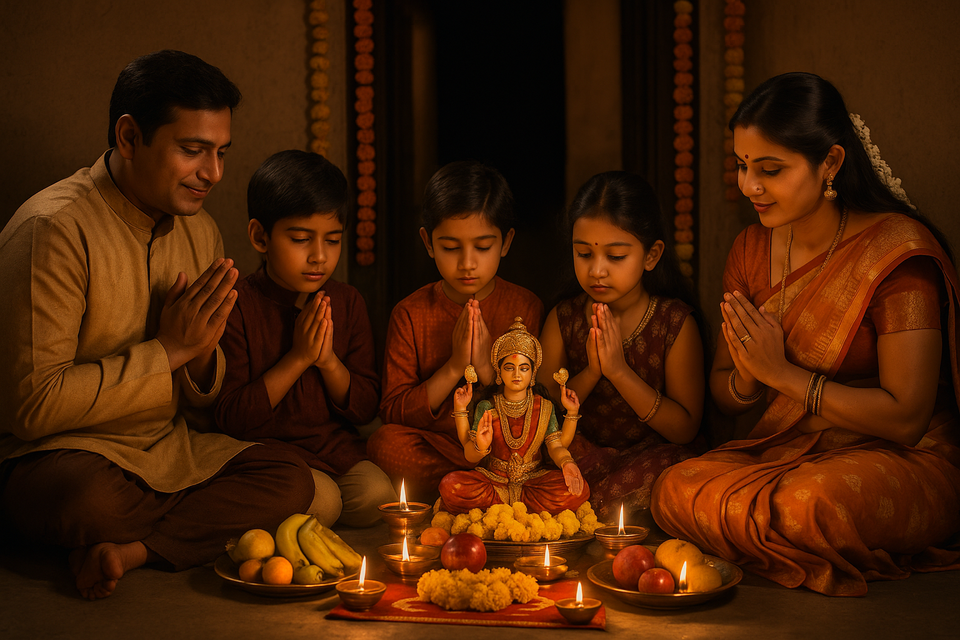Durga Puja ( Durgotsava )
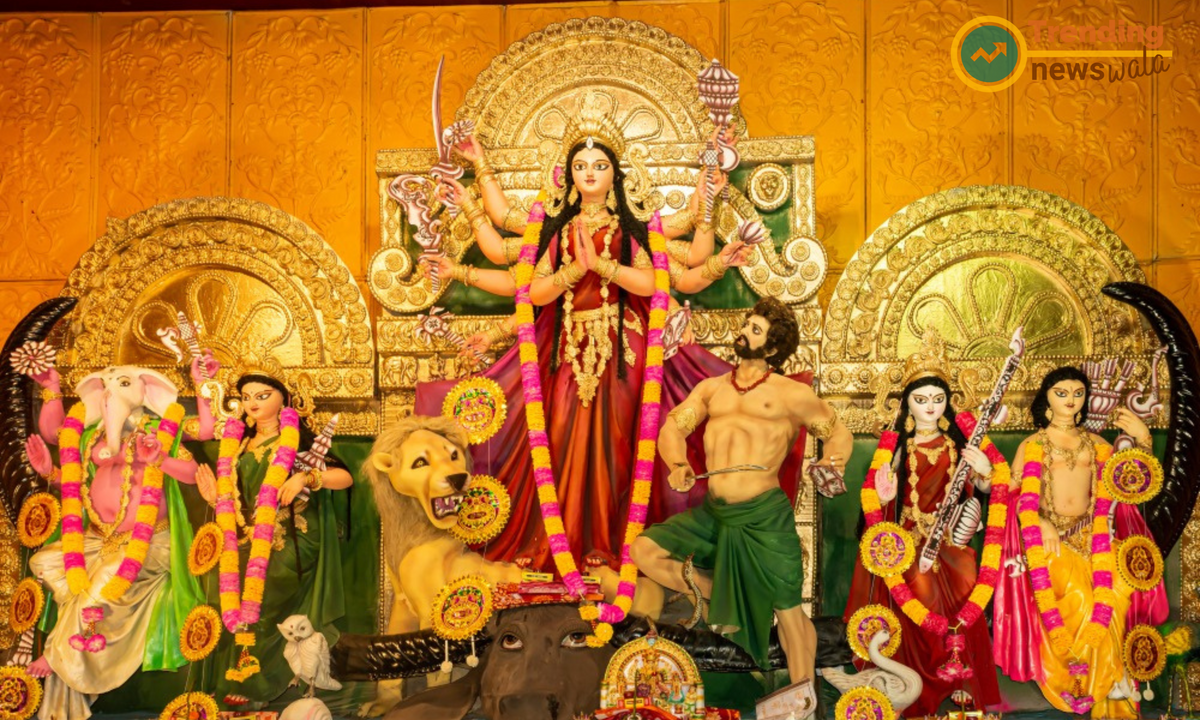
Durga Puja, with its grandeur, devotion, and cultural richness, stands as a testament to the enduring faith and spiritual heritage of the Hindu tradition. As devotees gather to worship Goddess Durga with splendor and devotion, they are reminded of the eternal presence of the divine mother in their lives, guiding them with love, strength, and compassion. May Durga Puja inspire all beings to embrace the divine within themselves and cultivate a spirit of unity, harmony, and reverence for all creation.
Durga Puja is not only a religious festival but also a cultural extravaganza that showcases the rich heritage and traditions of India. It brings communities together, transcending barriers of caste, creed, and nationality, as people from all walks of life come together to celebrate the divine mother with joy and fervor. The festival is marked by cultural performances, including music, dance, drama, and art exhibitions, which add to the festive atmosphere and cultural vibrancy of the occasion.
Durga Puja (Durgotsava): Celebrating the Divine Mother with Splendor and Devotion

Durga Puja, also known as Durgotsava, stands as one of the most vibrant and celebrated festivals in the Hindu calendar. This grand occasion reveres the divine mother, Goddess Durga, who epitomizes strength, compassion, and the triumph of good over evil. With its elaborate rituals, colorful decorations, and fervent devotion, Durga Puja captivates millions of devotees worldwide, uniting them in a joyous celebration of faith, culture, and community. Let's embark on a journey to explore the significance, rituals, and cultural richness of Durga Puja.
- Durga Puja (Durgotsava): Celebrating the Divine Mother with Splendor and Devotion: Durga Puja, also known as Durgotsava, is one of the most cherished and vibrant festivals in the Hindu calendar. It is a grand celebration honoring Goddess Durga, the epitome of strength, courage, and divine motherhood. This auspicious occasion brings together millions of devotees across the globe, transcending boundaries of religion and culture, to revel in the glory of the divine mother. With its elaborate rituals, colorful decorations, and fervent devotion, Durga Puja epitomizes the spirit of festivity, faith, and cultural heritage.
- The Essence of Durga Puja: Durga Puja holds deep spiritual significance as it commemorates the victory of Goddess Durga over the demon Mahishasura. According to Hindu mythology, the goddess manifested with her divine weapons and prowess to vanquish the forces of evil, restoring peace and righteousness to the universe. Devotees worship Durga as the divine mother who protects them from harm, dispels darkness, and bestows blessings for prosperity, happiness, and spiritual growth.
- Preparations and Festivities: The preparations for Durga Puja commence months in advance, characterized by meticulous planning and enthusiastic participation. Skilled artisans craft exquisite idols of Goddess Durga and her divine entourage, meticulously sculpting each deity with intricate details and vibrant colors. Temporary temples, known as pandals, are erected in neighborhoods and communities, adorned with elaborate decorations, thematic designs, and dazzling lighting arrangements. The air is filled with excitement and anticipation as devotees eagerly await the arrival of Maa Durga.
- Rituals and Observances: Durga Puja spans nine days, known as Navaratri, each day dedicated to a different aspect of Goddess Durga. Devotees observe fasts, perform puja (worship), and recite sacred hymns and mantras to invoke the blessings of the divine mother. Offerings of flowers, fruits, sweets, and incense are made to the goddess, symbolizing reverence, devotion, and gratitude. The atmosphere reverberates with the sounds of dhak (drums) and conch shells, creating an aura of spirituality and sanctity.
- Idol Immersion (Visarjan): The conclusion of Durga Puja is marked by the immersion of the idol of Goddess Durga in rivers or water bodies, symbolizing her return to the celestial abode. Devotees participate in colorful processions, accompanied by music, dance, and festive revelry, as they bid farewell to the goddess with mixed emotions of joy and melancholy. The immersion ceremony is a poignant reminder of the transient nature of life and the eternal presence of the divine mother in the hearts of her devotees.
- Cultural Extravaganza: Durga Puja is not just a religious festival; it is a cultural extravaganza that showcases the rich heritage and traditions of India. It brings communities together, fostering a spirit of unity, camaraderie, and shared celebration. The festival is marked by cultural performances, including music, dance, drama, and art exhibitions, which add to the festive ambiance and cultural vibrancy of the occasion. Durga Puja transcends boundaries of caste, creed, and nationality, uniting people from diverse backgrounds in a celebration of joy, faith, and cultural identity.
- Durga Puja is more than just a festival; it is a celebration of the divine mother, a reaffirmation of faith, and a testament to the enduring spirit of devotion and cultural heritage. As devotees come together to worship Goddess Durga with splendor and devotion, they experience a profound sense of joy, harmony, and spiritual fulfillment. May the divine blessings of Maa Durga bring peace, prosperity, and happiness to all her devotees, and may the spirit of Durga Puja inspire humanity to embrace love, compassion, and unity.
The Significance of Durga Puja:

Durga Puja commemorates the victory of Goddess Durga over the demon Mahishasura, symbolizing the victory of righteousness over evil. According to Hindu mythology, Goddess Durga manifested with divine weapons and prowess to vanquish the demon, restoring peace and harmony to the universe. Devotees worship Goddess Durga as the divine mother who protects them from harm and bestows blessings for prosperity, well-being, and spiritual growth.
- The Significance of Durga Puja: Honoring the Divine Mother and Embracing Spiritual Renewal: Durga Puja, a festival deeply rooted in Hindu mythology and tradition, holds profound significance for millions of devotees worldwide. This grand celebration, dedicated to Goddess Durga, symbolizes the triumph of good over evil, the power of righteousness, and the eternal bond between the divine and the devotee. Let's delve into the significance of Durga Puja and explore the spiritual and cultural richness it embodies.
- Commemorating the Victory of Good over Evil: At its core, Durga Puja commemorates the victory of Goddess Durga over the demon Mahishasura. According to Hindu mythology, Mahishasura, fueled by his arrogance and tyranny, unleashed chaos and terror upon the world. In response, the gods invoked Goddess Durga, who manifested with her divine weapons and vanquished the demon, restoring peace and righteousness to the universe. Durga Puja serves as a reminder of the eternal battle between good and evil and the ultimate triumph of righteousness.
- Revering the Divine Feminine: Goddess Durga is revered as the divine mother who embodies the qualities of strength, courage, and compassion. She is depicted as a fierce warrior goddess, adorned with weapons, riding atop a lion or tiger. Durga Puja celebrates the divine feminine principle, honoring the nurturing and protective aspect of the goddess. Devotees worship Durga as the mother who protects them from harm, nurtures them with love, and bestows blessings for prosperity, well-being, and spiritual growth.
- Embracing Spiritual Renewal: Durga Puja marks a time of spiritual renewal and inner transformation for devotees. The festival spans nine days, known as Navaratri, during which devotees observe fasting, perform rituals, and engage in prayers and meditation. Each day of Navaratri is dedicated to a different aspect of Goddess Durga, allowing devotees to deepen their connection with the divine mother and seek her blessings for spiritual growth and enlightenment. Durga Puja inspires devotees to let go of negativity, embrace positivity, and cultivate virtues such as courage, compassion, and humility.
- Fostering Community and Unity: Durga Puja is not just a religious festival; it is a celebration of community, culture, and camaraderie. The festival brings people from all walks of life together, transcending barriers of caste, creed, and nationality. Communities come alive with vibrant colors, festive decorations, and cultural performances, creating an atmosphere of joy, harmony, and shared celebration. Durga Puja fosters a sense of unity and solidarity among devotees, reinforcing the bonds of friendship, family, and community.
- Promoting Cultural Heritage: Durga Puja is a cultural extravaganza that showcases the rich heritage and traditions of India. Artisans craft exquisite idols of Goddess Durga and her divine entourage, while pandals (temporary temples) are adorned with elaborate decorations and thematic designs. The festival is marked by cultural performances, including music, dance, drama, and art exhibitions, which add to the festive ambiance and cultural vibrancy of the occasion. Durga Puja serves as a platform for preserving and promoting cultural heritage, passing down traditions from one generation to the next.
- Durga Puja is more than just a religious festival; it is a celebration of faith, culture, and community. It symbolizes the victory of good over evil, the divine feminine principle, and the eternal bond between the devotee and the divine mother. As devotees come together to worship Goddess Durga with reverence and devotion, they experience a sense of spiritual renewal, unity, and cultural pride. May the divine blessings of Maa Durga bring peace, prosperity, and happiness to all her devotees, and may the spirit of Durga Puja inspire humanity to embrace love, compassion, and unity.
Preparations and Festivities:

Months before the festival, preparations for Durga Puja begin with great fervor and enthusiasm. Artisans craft intricate idols of Goddess Durga and her divine entourage, depicting them in vibrant colors and elaborate adornments. Pandals, or temporary temples, are erected in neighborhoods and communities, each adorned with elaborate decorations, thematic designs, and intricate lighting arrangements. Devotees eagerly await the arrival of Maa Durga, who is believed to descend to earth during this auspicious time.
- Preparations and Festivities: The Vibrant Tapestry of Durga Puja Celebration: Durga Puja, the grand festival dedicated to Goddess Durga, is not just an event; it's an experience that captivates the hearts and minds of millions. From the meticulous preparations to the joyous festivities, every aspect of Durga Puja reflects the cultural richness, spiritual fervor, and community spirit of this auspicious occasion. Let's delve into the vibrant tapestry of preparations and festivities that define Durga Puja celebration.
- Crafting Exquisite Idols: Months before the festival, skilled artisans embark on the sacred task of crafting exquisite idols of Goddess Durga and her divine entourage. Working with clay, straw, and bamboo, they sculpt each deity with meticulous attention to detail, infusing life and divinity into their creations. The process is a labor of love, with artisans pouring their heart and soul into every stroke, ensuring that the idols radiate beauty, grace, and majesty.
- Erecting Pandals (Temporary Temples): As Durga Puja approaches, communities come alive with the hustle and bustle of pandal construction. Temporary temples, known as pandals, are erected in neighborhoods and public spaces, transforming ordinary surroundings into dazzling spectacles of devotion and creativity. Bamboo frames are adorned with vibrant fabrics, intricate decorations, and thematic designs, creating a visual feast for the eyes. Each pandal tells a story, evoking themes of mythology, tradition, and contemporary issues, adding depth and meaning to the festival.
- Decorating with Splendor: No expense is spared when it comes to decorating for Durga Puja. Pandals are embellished with elaborate decorations, ranging from traditional motifs to innovative designs that push the boundaries of creativity. Flowers, lights, and fabrics adorn every corner, creating an atmosphere of splendor and grandeur. The pandals become works of art in themselves, drawing admirers from far and wide who marvel at the ingenuity and craftsmanship on display.
- Observing Rituals and Traditions: Durga Puja is marked by a plethora of rituals and traditions that deepen the devotee's connection with the divine mother. Each day of the festival is filled with puja (worship), offerings, and prayers, as devotees seek the blessings of Goddess Durga for prosperity, well-being, and spiritual fulfillment. From the recitation of sacred hymns to the performance of elaborate rituals such as Abhishekam (ritual bathing), every aspect of Durga Puja is steeped in symbolism and devotion.
- Indulging in Festive Delights: No celebration is complete without indulging in festive delights, and Durga Puja is no exception. Food stalls line the streets, offering a tantalizing array of culinary delights ranging from traditional sweets to savory snacks. Devotees savor mouthwatering delicacies such as luchi, cholar dal, alur dom, and sweets like sandesh and rasgulla, indulging their taste buds in the flavors of Bengal and beyond.
- Enjoying Cultural Extravaganza: Durga Puja is not just a religious festival; it's a cultural extravaganza that showcases the rich heritage and traditions of India. Cultural performances, including music, dance, drama, and art exhibitions, add to the festive ambiance, entertaining audiences and enriching their cultural experience. From classical recitals to contemporary fusion, the festival offers something for everyone, fostering a spirit of camaraderie and appreciation for the arts.
- Durga Puja is a celebration like no other, where devotion, creativity, and community spirit come together in a harmonious symphony of colors, sounds, and emotions. From the intricate craftsmanship of idol makers to the joyous festivities of pandal-hopping, every aspect of Durga Puja celebration reflects the boundless enthusiasm and reverence of devotees. As communities unite to worship Goddess Durga with splendor and devotion, they create memories that linger long after the festival ends, weaving a tapestry of joy, love, and cultural pride.
Rituals and Observances:

Durga Puja is marked by elaborate rituals and observances that deepen the devotee's connection with the divine mother. The festival typically spans nine days, known as Navaratri, with each day dedicated to a different aspect of Goddess Durga. Devotees perform puja (worship) of the goddess, offering flowers, fruits, sweets, and other offerings. They also chant sacred hymns and mantras, invoking the blessings of Goddess Durga for protection, prosperity, and spiritual fulfillment.
- Rituals and Observances: Delving into the Sacred Traditions of Durga Puja: Durga Puja, the grand festival dedicated to Goddess Durga, is not just a celebration; it's a spiritual journey that unfolds through a tapestry of rituals and observances. These sacred traditions, handed down through generations, deepen the devotee's connection with the divine mother and evoke a sense of reverence, devotion, and spiritual fulfillment. Let's delve into the rich tapestry of rituals and observances that define the essence of Durga Puja.
- Mahalaya: Invoking the Divine Mother: The festivities of Durga Puja commence with Mahalaya, a special day dedicated to invoking the presence of Goddess Durga. Devotees wake up before dawn to listen to Mahalaya recitations, which depict the descent of the goddess to earth and her epic battle with the demon Mahishasura. The chanting of hymns and mantras fills the air, setting the stage for the divine festivities that lie ahead.
- Maha Saptami, Maha Ashtami, and Maha Navami: Worship and Offerings:The main rituals of Durga Puja unfold over three consecutive days: Maha Saptami, Maha Ashtami, and Maha Navami. Each day is marked by elaborate worship (puja), offerings, and rituals performed to honor Goddess Durga and her divine entourage. Devotees adorn the goddess with flowers, garlands, and vermillion, while priests chant sacred hymns and mantras invoking her blessings.
- Kumari Puja: Worship of the Divine Feminine: On Maha Ashtami, a special ritual known as Kumari Puja is performed, where young girls symbolizing the divine feminine aspect of Goddess Durga are worshiped. These girls, often between the ages of two and ten, are believed to embody the purity and innocence of the goddess herself. Devotees offer prayers and seek blessings from the Kumari, believing that her presence brings prosperity, protection, and spiritual fulfillment.
- Sandhi Puja: The Auspicious Moment of Transition: One of the most significant rituals of Durga Puja is Sandhi Puja, performed during the transition from Maha Ashtami to Maha Navami, at the exact moment when the Ashtami tithi ends, and the Navami tithi begins. Devotees believe that this auspicious moment is charged with divine energy, and performing puja during this time invokes the blessings of Goddess Durga in abundance.
- Vijaya Dashami: Immersion of the Idol: The final day of Durga Puja, known as Vijaya Dashami or Dussehra, culminates with the immersion of the idol of Goddess Durga in rivers or water bodies. Devotees bid farewell to the goddess with tearful eyes and joyous hearts, accompanied by music, dance, and festive processions. The immersion symbolizes the departure of the goddess to her celestial abode, marking the end of her earthly sojourn and the triumph of good over evil.
- Anjali: Offering Prayers and Devotion: Throughout Durga Puja, devotees offer Anjali, a ritual of offering prayers and devotion to the goddess. Devotees gather in temples or pandals, reciting sacred hymns and mantras while offering flowers, fruits, and sweets to Goddess Durga. Anjali is a deeply personal and heartfelt expression of devotion, as devotees surrender themselves to the divine mother, seeking her blessings for prosperity, well-being, and spiritual growth.
- Rituals and observances lie at the heart of Durga Puja, guiding devotees on a sacred journey of spiritual awakening, reverence, and devotion. From the invocation of the divine mother to the immersion of her idol, each ritual is infused with symbolism and significance, connecting devotees with the eternal presence of Goddess Durga. As devotees immerse themselves in these sacred traditions, they experience the transformative power of faith, love, and devotion, paving the way for spiritual growth and enlightenment.
Idol Immersion (Visarjan):

The culmination of Durga Puja is marked by the immersion of the idol of Goddess Durga in rivers or water bodies, symbolizing her return to her celestial abode. Devotees participate in colorful processions, accompanied by music, dance, and festive revelry, as they bid farewell to the goddess with tearful eyes and joyous hearts. The immersion ceremony is a poignant reminder of the transient nature of life and the eternal presence of the divine mother in the hearts of her devotees.
- Idol Immersion (Visarjan): A Poignant Farewell to the Divine Mother: Idol immersion, or Visarjan, marks the culmination of the grand festival of Durga Puja, a moment both poignant and joyous as devotees bid farewell to the divine mother, Goddess Durga. This ritual, steeped in symbolism and tradition, holds profound significance in Hindu culture, signifying the departure of the deity from the earthly realm to her celestial abode. Let's delve into the spiritual and cultural aspects of idol immersion and explore the emotions and sentiments that accompany this sacred act.
- Symbolism of Idol Immersion: Idol immersion symbolizes the cyclical nature of existence, the impermanence of life, and the eternal presence of the divine. The immersion of the idol of Goddess Durga in rivers or water bodies signifies her return to her celestial abode after her earthly sojourn. It represents the transient nature of the material world and the eternal journey of the soul towards spiritual liberation.
- The Ritual of Visarjan: The ritual of idol immersion is a solemn yet festive occasion, marked by elaborate processions, music, dance, and fervent devotion. Devotees carry the beautifully adorned idol of Goddess Durga on elaborately decorated floats or palanquins, accompanied by joyous chants and rhythmic beats of drums and cymbals. The atmosphere is charged with emotion as devotees bid farewell to the goddess with tearful eyes and heartfelt prayers.
- Emotional Farewell: For devotees, idol immersion is a bittersweet moment, filled with mixed emotions of joy and sadness. On one hand, there is a sense of gratitude and fulfillment for the divine blessings received during the festival. On the other hand, there is a deep sense of sorrow at the departure of the beloved goddess, whose presence brought joy, hope, and protection. Devotees express their emotions through tearful farewells, heartfelt prayers, and vows of devotion.
- Community Spirit: Idol immersion is not just a religious ritual; it's a celebration of community, culture, and camaraderie. People from all walks of life come together to participate in the festivities, transcending barriers of caste, creed, and nationality. The immersion processions become a spectacle of unity and diversity, as devotees sing, dance, and rejoice in the company of their fellow worshipers.
- Environmental Consciousness: In recent years, there has been a growing emphasis on eco-friendly idol immersion to minimize the environmental impact of the festival. Many communities have adopted practices such as using clay idols, natural dyes, and biodegradable materials to ensure that the immersion process does not harm the ecosystem. Additionally, efforts are made to clean up the water bodies post-immersion, ensuring their preservation for future generations.
- Spiritual Significance: Beyond the outward rituals and festivities, idol immersion holds deep spiritual significance for devotees. It symbolizes the act of surrendering the ego and letting go of attachments, paving the way for spiritual growth and liberation. As the idol of Goddess Durga merges with the waters, devotees are reminded of the impermanence of life and the eternal presence of the divine within themselves.
- Idol immersion, or Visarjan, is a poignant ritual that marks the end of Durga Puja festivities, yet it also heralds the beginning of a new spiritual journey for devotees. As they bid farewell to the divine mother with tears in their eyes and love in their hearts, they carry with them the blessings and grace of Goddess Durga, guiding them on the path of righteousness, devotion, and spiritual awakening. Truly, idol immersion is not just a ritual; it's a sacred act of devotion, gratitude, and surrender to the divine.
Cultural Extravaganza:

Durga Puja is not only a religious festival but also a cultural extravaganza that showcases the rich heritage and traditions of India. It brings communities together, transcending barriers of caste, creed, and nationality, as people from all walks of life come together to celebrate the divine mother with joy and fervor. The festival is marked by cultural performances, including music, dance, drama, and art exhibitions, which add to the festive atmosphere and cultural vibrancy of the occasion.
- Cultural Extravaganza: Exploring the Vibrant Tapestry of Durga Puja: Durga Puja, the grand festival dedicated to Goddess Durga, transcends religious boundaries to become a cultural extravaganza that captivates the hearts and minds of millions. Beyond its religious significance, Durga Puja is a celebration of art, music, dance, and creativity, showcasing the rich cultural heritage of India. From vibrant pandals to mesmerizing performances, let's delve into the cultural extravaganza that unfolds during Durga Puja.
- Pandals: Temples of Creativity: One of the most striking features of Durga Puja is the elaborately decorated pandals, or temporary temples, that spring up across cities and towns. These pandals serve as canvases for artists and craftsmen to unleash their creativity, with each pandal boasting unique themes, designs, and decorations. From traditional motifs to contemporary concepts, pandals transport visitors to a world of enchantment and wonder, showcasing the diverse cultural tapestry of India.
- Artistry in Idol Making: The craftsmanship and artistry involved in making idols of Goddess Durga and her divine entourage are awe-inspiring. Skilled artisans meticulously sculpt each deity with clay, straw, and bamboo, infusing life and divinity into their creations. The idols, adorned with intricate details and vibrant colors, become objects of reverence and admiration, symbolizing the divine presence amidst mortals.
- Music and Dance Performances: Durga Puja is synonymous with music and dance, with cultural performances taking center stage during the festivities. From classical recitals to folk dances and modern fusion, a myriad of performances enthrall audiences, celebrating the rich musical and dance traditions of India. Musicians, dancers, and performers grace the stages of pandals, weaving a tapestry of melodies and rhythms that resonate with the soul.
- Drama and Theater:Theater and drama also play a significant role in Durga Puja celebrations, with theatrical performances depicting mythological stories, historical events, and contemporary issues. These dramatic presentations not only entertain but also educate and inspire, fostering a deeper understanding of culture, society, and spirituality among the audience.
- Art Exhibitions and Workshops: Durga Puja provides a platform for artists, sculptors, and craftsmen to showcase their talents through art exhibitions and workshops. Visitors can marvel at paintings, sculptures, and handicrafts that reflect the cultural diversity and artistic excellence of India. Workshops offer an opportunity for enthusiasts to learn traditional art forms such as pottery, clay modeling, and painting, preserving and promoting these ancient crafts for future generations.
- Culinary Delights: No cultural extravaganza is complete without indulging in culinary delights, and Durga Puja is no exception. Food stalls line the streets, offering a delectable array of traditional Bengali cuisine and street food favorites. From mouthwatering sweets like sandesh and rasgulla to savory snacks like luchi, alur dom, and cholar dal, the festival is a gastronomic delight for food lovers.
- Durga Puja is not just a religious festival; it's a celebration of culture, creativity, and community spirit. The cultural extravaganza that unfolds during the festivities showcases the best of Indian art, music, dance, theater, and cuisine, uniting people from all walks of life in a joyous celebration of diversity and tradition. As visitors immerse themselves in the vibrant tapestry of cultural experiences, they experience the richness and beauty of India's cultural heritage, leaving them with memories to cherish for a lifetime.

Durga Puja, also known as Durgotsava, is a grand festival celebrated with fervor and devotion by millions of people worldwide. From its origins to its significance and rituals, there are many questions that arise about this auspicious occasion. Here are some frequently asked questions about Durga Puja, along with their answers:
What is Durga Puja?
Durga Puja is a Hindu festival dedicated to Goddess Durga, the divine mother who symbolizes strength, power, and protection. It celebrates the victory of good over evil, as depicted in Hindu mythology through the triumph of Goddess Durga over the demon Mahishasura.
When is Durga Puja celebrated?
Durga Puja is typically celebrated during the Hindu calendar month of Ashwin, which usually falls in September or October according to the Gregorian calendar. The festival spans over four to five days, culminating with Vijaya Dashami, also known as Dussehra.
What are the main rituals of Durga Puja?
The main rituals of Durga Puja include the installation of the idol of Goddess Durga, known as Pratima Sthapana, elaborate worship (puja) ceremonies, offerings of flowers and prasad, recitation of sacred hymns and mantras, and immersion (Visarjan) of the idol in water bodies.
Why is Durga Puja celebrated?
Durga Puja commemorates the victory of Goddess Durga over the demon Mahishasura, signifying the triumph of good over evil. It is also a time to seek the blessings of Goddess Durga for protection, prosperity, and spiritual well-being.
What are the significance and symbolism of the Durga Puja idol?
The idol of Goddess Durga is symbolic of her divine attributes and powers. She is depicted as a fierce warrior goddess, adorned with weapons, riding atop a lion or tiger. The idol symbolizes the victory of righteousness over evil and the protection offered by the divine mother to her devotees.
How is Durga Puja celebrated across different regions of India?
Durga Puja is celebrated with great pomp and splendor across various regions of India, with each region adding its own unique customs and traditions to the festivities. In West Bengal, it is a major cultural event marked by elaborately decorated pandals and vibrant processions. In other parts of India, such as Bihar, Assam, and Odisha, Durga Puja is celebrated with traditional rituals and rituals unique to the local culture.
Are there any special foods associated with Durga Puja?
Yes, Durga Puja is a time for feasting and indulging in delicious traditional foods. Some popular dishes enjoyed during the festival include luchi, cholar dal, alur dom, khichuri, and a variety of sweets like sandesh, rasgulla, and mishti doi.
How do devotees participate in Durga Puja celebrations?
Devotees participate in Durga Puja celebrations by visiting pandals, offering prayers and offerings to the goddess, attending cultural programs and performances, and partaking in community feasts and festivities. They also observe fasts and perform rituals at home or in temples to seek the blessings of Goddess Durga.
What is the significance of idol immersion (Visarjan) in Durga Puja?
Idol immersion, or Visarjan, symbolizes the departure of Goddess Durga from the earthly realm to her celestial abode after her annual visit. It is a poignant moment of farewell for devotees, marking the end of the festival while also symbolizing the cyclical nature of existence and the impermanence of life.
How can one participate in Durga Puja celebrations?
One can participate in Durga Puja celebrations by visiting pandals, attending puja ceremonies and cultural programs, offering prayers and offerings to the goddess, and joining in community activities and festivities. It is also a time for introspection, prayer, and seeking blessings for oneself and loved ones.
Durga Puja is not just a religious festival; it is a cultural extravaganza that unites people of all backgrounds in a celebration of faith, tradition, and community spirit. By understanding its significance and rituals, one can fully appreciate the beauty and richness of this auspicious occasion.

